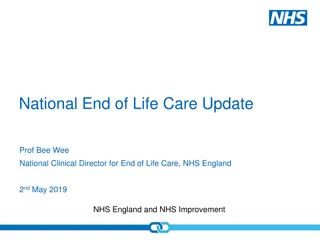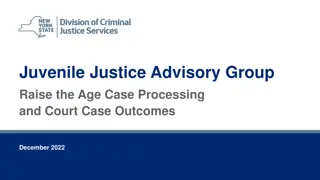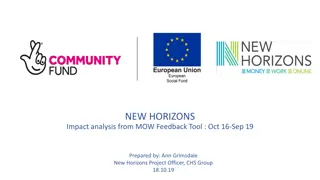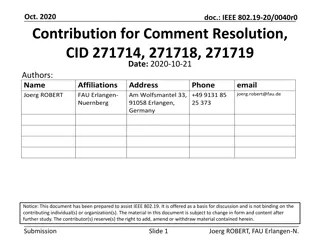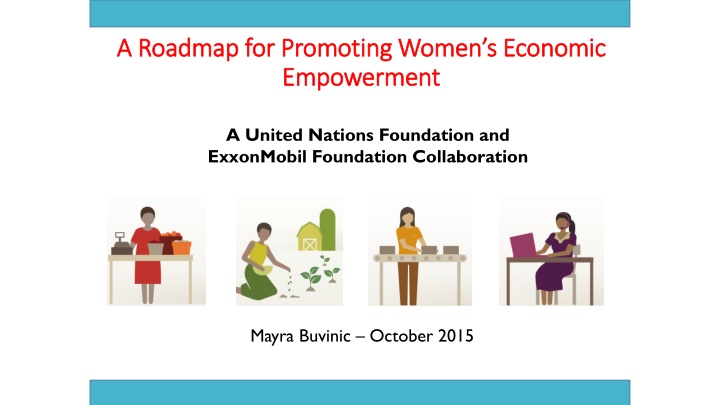
Empowering Women's Economic Progress: Insights and Strategies
Discover a comprehensive roadmap for promoting women's economic empowerment through targeted interventions, categorized by entrepreneurship, farming, wage employment, and young women's employment. Gain insights on proven, promising, and high-potential interventions across different country scenarios and populations, offering valuable lessons for advancing women's economic well-being.
Download Presentation

Please find below an Image/Link to download the presentation.
The content on the website is provided AS IS for your information and personal use only. It may not be sold, licensed, or shared on other websites without obtaining consent from the author. If you encounter any issues during the download, it is possible that the publisher has removed the file from their server.
You are allowed to download the files provided on this website for personal or commercial use, subject to the condition that they are used lawfully. All files are the property of their respective owners.
The content on the website is provided AS IS for your information and personal use only. It may not be sold, licensed, or shared on other websites without obtaining consent from the author.
E N D
Presentation Transcript
A Roadmap for Promoting Womens Economic A Roadmap for Promoting Women s Economic Empowerment Empowerment A United Nations Foundation and ExxonMobil Foundation Collaboration Mayra Buvinic October 2015
A Roadmap for Promoting Womens Economic Empowerment A Roadmap for Promoting Women s Economic Empowerment Answers question: what works for whom and where? Measures changes in women s productivity and earnings Includes 18 research commissions Reviews empirical evaluations of 136 interventions Covers four categories: entrepreneurship, farming, wage employment, and young women s employment Target audiences: private sector and private/public collaboration Ranks according to strength of evidence, cost-effectiveness and duration impacts.
Roadmap Guideposts Roadmap Guideposts What proven, promising, high potential and unproven interventions For whom very poor, poor, non-poor, and young women Where country scenarios defined by demographic trends and job prospects
Country Scenarios Country Scenarios High fertility agrarian economies Declining fertility urbanizing economies Declining fertility formalizing economies Aging populations and societies Cross-cutting scenarios: Conflict affected economies Resource rich countries and small island states
Where? Where? Agrarian Economies High Fertility High Fertility Agrarian Economies Categories of women most likely to seek work: Very poor entrepreneurs and poor entrepreneurs Poor farmers Non-poor farmers Young women Proven and promising interventions Complementary interventions (for women) A. Family planning and RH information and intervention B. Schooling investments
Overall Lessons from the Roadmap Overall Lessons from the Roadmap 1. Heterogeneity affects outcomes: same class of interventions has different outcomes depending on client. Capital (loan or grant) alone work for SMEs; does not work for subsistence level enterprises; may work for microenterprises. The very poor need more: very poor women need more intensive package of services to break out of subsistence production. What works for young women does not necessarily work for adult women. Young women may self-source better, face fewer constraints and fewer opportunities.
Overall Lessons from the Roadmap Overall Lessons from the Roadmap 2. Women face additional constraints: pre-existing gender differences and inequalities affect outcome of intervention. Differences in outcomes favoring men likely due to women having a. More severe business constraints (less efficient industries and sectors.) b. More severe social pressures to divert capital (internally or externally motivated) c. Combination Clever design adjustments are available: simple, clear features can help women overcome family and social pressures (nudge) and provide autonomy (mobile phones.) Clever design adjustments include adapting designs to women s needs.
Overall Lessons from the Roadmap Overall Lessons from the Roadmap 3. Female autonomy helps produce better outcomes: Proxies for autonomy include sole income earners, FHH Alternative explanation is that service provision has been biased to MHH. Autonomy seems less important to explain outcomes in wage employment (more developed or more conducive environment.)
Overall Lessons from the Roadmap Overall Lessons from the Roadmap 4. Knowledge gaps: Characteristics and determinants of success cross-overs , successful school to work transitions, upward mobility in wage work. Successful profiles would help with selection Lessons from failed programs Impact of business networks, mentors, firm certification Evidence on financial & economic costs & sustainability
How to Measure What Works? How to Measure What Works? Think Pieces by: Oriana Bandiera, London School of Economics James C. Knowles, Independent Consultant Agnes R. Quisumbing, Cheryl Doss, Nancy Johnson and Ruth Meinzen-Dick, International Food Policy Research Institute Martin Valdivia, GRADE, Peru Christopher Woodruff, University of Warwick
Causal Chain: Causal Chain: Outcomes and Indicators Outcomes and Indicators
Roadmap Measures Website Roadmap Measures Website www.womeneconroadmap.org/measurement www.womeneconroadmap.org/measurement Web content: Measuring highlights Suggested intermediate and final outcome indicators Links to selected questionnaires for each suggested indicator Supplementary measurement guidelines
Six Principles Six Principles 1. Given the interdependence of women s economic and social roles, it is important to measure both economic and social outcomes to understand women s economic empowerment. 2. It is also important to measure both individual and household effects, considering the broader context of women s well-being in the household. 3. The what and the how of an evaluation matter equally: what refers to the outcomes measured, how to the evaluation design. 4. No evaluation is better than a poorly designed evaluation. 5. Not every program can be rigorously evaluated, but we can learn something of value from every program. 6. Complementary qualitative work is important to understand the why behind results, which can be quite useful for program staff.
Good Practices Good Practices for questionnaire design for questionnaire design Keep it numerical Keep it easy Keep it short Keep it consistent Give a way out






